Fellow lawn enthusiasts! Ever noticed how heavy rainfall can turn your perfectly manicured lawn into a muddy mess? That’s erosion at play, and it’s more than just a cosmetic issue. Erosion can wash away topsoil, jeopardizing your green oasis. But fear not – a well-thought-out drainage plan is your lawn’s superhero! In this blog post, Liberty Heritage Nursery Farm helps to explore practical and friendly ways to keep your turf intact, from understanding the landscape to installing nifty features like French drains and swales. So, grab your gardening gloves, and let’s dive into the world of effective lawn drainage!
Understanding the Causes of Erosion

Before delving into the solutions, it’s crucial to understand the factors contributing to erosion. Rainfall, improper slope grading, compacted soil, and poor drainage systems are common culprits. When water accumulates on the surface without proper drainage, it can lead to runoff, carrying away soil particles and nutrients, ultimately causing erosion. By addressing these root causes, you can create a resilient and erosion-resistant lawn.
Erosion is like a stealthy intruder in your lawn, quietly stealing away the precious topsoil. Rainfall, poorly graded slopes, compacted soil, and inadequate drainage systems are the culprits. When rainwater can’t seep into the ground and starts pooling or running off, it takes soil particles along for the ride, causing erosion. Knowing these foes helps us build a robust defense – a drainage strategy tailored to combat the specific challenges our landscapes face.
Evaluate the Landscape:
Start by conducting a thorough evaluation of your landscape. Identify areas prone to water accumulation, low spots, and regions with poor drainage. Understanding the natural flow of water on your property will help in designing an effective drainage system tailored to your specific needs.
Start your erosion defense by sizing up your landscape. Identify trouble spots where water tends to accumulate and low areas prone to saturation. Take note of the natural flow of water across your property. Understanding these nuances sets the stage for a tailored drainage solution. By evaluating your landscape, you can strategically plan grading adjustments, swales, or other features to redirect water flow and prevent erosion in vulnerable areas. It’s the first step in creating a resilient and erosion-resistant lawn.
Evaluating the landscape is akin to deciphering the blueprint of your lawn’s resilience. By identifying trouble spots, such as areas prone to water accumulation or low-lying regions, you gain insights crucial for effective erosion prevention. Understanding the natural flow of water across your property allows for targeted interventions, be it through slope grading or the installation of drainage features. This initial assessment lays the foundation for a tailored strategy, ensuring that your landscape is well-equipped to withstand the challenges of water runoff and erosion.
Slope Grading:
One of the primary contributors to erosion is improper slope grading. Ensure that your landscape has a gentle slope away from buildings or critical areas. This facilitates proper water runoff and prevents the pooling of water, minimizing erosion risks. Professional landscapers can assist in reshaping the terrain if necessary.
Slope grading is your secret weapon against erosion. Ensure your landscape has a gentle slope away from buildings and critical areas, guiding water to flow naturally. Improper grading can lead to water pooling, making your lawn vulnerable to erosion. By sculpting the terrain to encourage proper runoff, you create a defense mechanism that minimizes the risk of soil loss and helps maintain a healthy, vibrant lawn.
Install Permeable Surfaces:
Choosing permeable surfaces, such as permeable pavers or gravel, helps water infiltrate the soil rather than creating runoff. This reduces surface water accumulation and promotes better absorption, minimizing erosion risks. Consider incorporating these permeable surfaces in areas with heavy foot traffic or near buildings.
Opting for permeable surfaces, like permeable pavers or gravel, is a smart move in erosion prevention. These surfaces allow water to infiltrate the soil instead of creating runoff, reducing surface water accumulation. By choosing permeable materials, you create pathways and areas that promote better water absorption, minimizing the risk of erosion in high-traffic zones or critical areas.
Enhance your landscape’s resilience against erosion by considering permeable surfaces like permeable pavers or gravel. These materials, expertly installed by professional landscaping services, not only add aesthetic appeal but also promote water infiltration, preventing runoff and erosion. Choose a trusted landscaping service to seamlessly integrate permeable surfaces into your design, ensuring a beautiful and erosion-resistant outdoor space.
Utilize Swales and Berms:
Swales and berms are effective landscape features that can redirect water flow. Swales are shallow depressions designed to collect and redirect water, while berms are raised mounds that help slow down and disperse water. Strategically placing these features can significantly reduce the impact of water runoff and erosion.
Harness the power of nature with swales and berms to fortify your landscape against erosion. Swales, shallow depressions, act as water channels, redirecting and slowing down water flow. Berms, raised mounds, provide an extra barrier, preventing runoff and encouraging water absorption. Strategically placing swales and berms, perhaps with the assistance of professional landscapers, creates a natural defense system. By guiding water away from vulnerable areas, these features help maintain soil integrity and ensure a lush, erosion-resistant lawn.
In Liberty Township, detecting and fixing lawn drainage problems early is essential for preserving the integrity of your outdoor space. Utilizing swales and berms becomes a pivotal aspect of this proactive approach. Swales act as natural channels, guiding water away from vulnerable areas, while berms provide added protection against runoff. Integrating these features aligns with the township’s commitment to sustainable landscaping practices, fostering resilient lawns that stand strong against erosion challenges.
Install French Drains:
For areas with persistent waterlogging, French drains can be a valuable addition. These drains consist of a perforated pipe surrounded by gravel and are installed underground to collect and redirect excess water away from vulnerable areas. French drains are particularly useful in preventing soil saturation and erosion in low-lying spots.
Combat excess water and erosion with the installation of French drains, a key player in effective drainage solutions. These underground drains, equipped with a perforated pipe and surrounded by gravel, efficiently collect and redirect water away from vulnerable areas. Professional drainage solutions, including French drains, ensure a comprehensive strategy to safeguard your landscape from erosion, maintaining soil stability and the overall health of your lawn.
Optimize Irrigation Practices:

Proper irrigation is crucial for maintaining a healthy lawn and preventing erosion. Avoid overwatering, as excessive moisture can lead to soil compaction and erosion. Invest in a well-designed irrigation system that ensures uniform water distribution and allows for efficient absorption by the soil.
- Smart irrigation minimizes water runoff, reducing erosion risks.
- Ensure uniform water distribution across the lawn.
- Use drip irrigation or soaker hoses to target specific areas, preventing excess moisture.
- Schedule watering during early morning or late evening to maximize absorption.
- Install rain sensors to automatically adjust irrigation based on weather conditions.
- Avoid overwatering, as it leads to soil compaction and erosion.
- Regularly inspect and maintain the irrigation system to ensure efficiency and prevent water wastage.
Promote Vegetative Cover:
Plants play a vital role in preventing erosion by stabilizing the soil with their root systems. Consider planting grasses, ground covers, and native vegetation to create a natural barrier against erosion. The roots help bind the soil together, reducing the impact of water runoff.
Planting a variety of grasses, ground covers, and native vegetation promotes a robust vegetative cover that acts as a natural defense against erosion. The roots of these plants help bind the soil, preventing runoff and enhancing the overall stability of your lawn.
In addition to preventing erosion, a lush vegetative cover provides numerous benefits, including improved soil structure and enhanced biodiversity. These plants contribute to a healthier ecosystem by attracting beneficial insects and wildlife. The aesthetic appeal they bring adds a touch of natural beauty to your landscape, making it a win-win solution for both environmental resilience and visual delight.
Mulching:
Applying organic mulch, such as wood chips or straw, can further enhance soil stability. Mulch acts as a protective layer, reducing the impact of rainfall on the soil surface. Additionally, it aids in water retention, preventing rapid runoff and erosion. Mulching serves as a protective shield in your battle against erosion. Applying organic mulch, like wood chips or straw, creates a barrier that reduces the impact of rainfall on the soil surface. This not only prevents rapid runoff but also aids in water retention. Mulch acts as a natural insulator, promoting moisture conservation and reducing soil erosion, contributing to a healthier and more sustainable lawn.
Regular Maintenance:
Consistent lawn maintenance is essential for preventing erosion. Regularly check and clean gutters and downspouts to ensure proper water flow. Remove debris and fallen leaves that could obstruct drainage channels, preventing water from accumulating in unwanted areas.
Consistent maintenance is the backbone of erosion prevention. Regularly check and clean gutters and downspouts to ensure unobstructed water flow. Remove debris, fallen leaves, or any obstacles that may impede drainage channels. Inspect the condition of your landscape and address any signs of erosion promptly. By staying proactive, you mitigate potential issues before they escalate, preserving the effectiveness of your drainage solutions. This ongoing care ensures a resilient and well-maintained lawn, standing strong against the forces of erosion.
Professional Assistance:
If designing and implementing a comprehensive drainage system seems overwhelming, seeking professional assistance is a wise decision. Landscaping experts can assess your property, recommend tailored solutions, and ensure the proper installation of drainage features to mitigate erosion risks effectively.
When the task feels daunting, seek the expertise of landscaping professionals. Their insights and experience can help assess your property, recommend tailored drainage solutions, and ensure the proper installation of features like French drains or swales. Professional assistance guarantees a comprehensive and effective approach to preventing erosion.
FAQs
What is the most effective way to prevent erosion?
For areas with light erosion problems, replanting with vegetation and covering with mulch are good solutions. For erosion along footpaths, covering with mulch or stone is the best option. For heavy erosion in areas of concentrated flow, the most effective solutions are check dams or terraces.
How does drainage affect erosion?
Improving subsurface drainage thus causes surface runoff, which occurs rapidly over a rela- tively short period of time, to be replaced by subsurface flow over a much longer pe- riod of time. Because soil particles are de- tached and transported by surface runoff, practices that reduce runoff should reduce erosion.
How do you stop erosion in a drainage ditch?
Line the ditch on all sides with landscape fabric to prevent soil erosion. Place a layer of gravel at the bottom of the ditch. A perforated plastic pipe is laid on top of the gravel and surrounded by gravel on the sides and top.
How can I improve my drainage system?
Steps to Improve Drainage
- Install subsurface tile drains. Tile drains are sections of perforated pipe buried 12 to 18 inches below the soil surface.
- Install vertical drains in tree and shrub planting holes.
- Plant in raised soil beds.
- Mix layers of soil.
What is proper drainage system?
An effective drainage system is one that removes all excess water without causing inconveniences in terms of design. For example, in an area with many buildings like residences and shops, there cannot be open drains that flow through the areas.
Conclusion
Safeguarding your lawn against erosion is not just about maintaining a picturesque landscape; it’s about preserving the health and resilience of your outdoor space. By understanding the causes of erosion and implementing targeted drainage solutions, such as slope grading, permeable surfaces, and vegetation cover, you create a robust defense system. Regular maintenance, mulching, and seeking professional assistance when needed ensure the longevity of your efforts. As you cultivate a lush, erosion-resistant lawn, you not only enhance the beauty of your property but also contribute to a sustainable and thriving ecosystem, making every effort a step towards a greener, healthier future.
